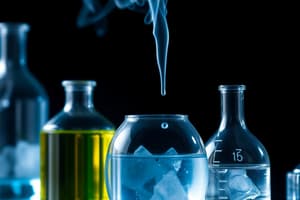Podcast
Questions and Answers
Match the words to their best definition/description.
Match the words to their best definition/description.
Acid = A substance that increases the hydrogen ion concentration in an aqueous solution. Open System = A system that can exchange matter and energy with the surroundings. Precipitate = An insoluble solid formed by a reaction in solution. Kinetic Energy = The energy of motion. Work = The energy used to cause an object with mass to move against a force. The 1st Law of Thermodynamics = Energy is conserved. Endothermic = A process in which the system absorbs heat from its surroundings. Internal energy = The sum of all the kinetic and potential energy of a system. Product = Substances written on the right of the arrow in a chemical equation. Reduction = The gain of electrons by a substance.
What are the spectator ions in the following precipitation reaction?
Mg(NO3)2(aq) + 2 NaOH(aq) → Mg(OH)2(s) + 2 NaNO3(aq)
What are the spectator ions in the following precipitation reaction? Mg(NO3)2(aq) + 2 NaOH(aq) → Mg(OH)2(s) + 2 NaNO3(aq)
- Mg2+ and OH-
- Na+ and OH-
- Mg2+ and NO3-
- Na+ and NO3- (correct)
What is the oxidation number of Cl in the compound, HCIO2?
What is the oxidation number of Cl in the compound, HCIO2?
3
Which element is oxidized and which is reduced in the reaction
8 H2S(g) + 4 O2(g) → S8(1) + 8 H2O(g)
Which element is oxidized and which is reduced in the reaction 8 H2S(g) + 4 O2(g) → S8(1) + 8 H2O(g)
If 0.372 moles of benzene (C6H6) react with 51.6 grams of bromine (Br2), what is the theoretical yield of bromobenzene, C6H5Br?
C6H6 + Br2→ C6H5Br + HBr
If 0.372 moles of benzene (C6H6) react with 51.6 grams of bromine (Br2), what is the theoretical yield of bromobenzene, C6H5Br? C6H6 + Br2→ C6H5Br + HBr
How many grams of Pb(NO3)2 are needed to completely precipitate all of the iodide ions from 250 mL of a 0.167 M potassium iodide solution?
Pb(NO3)2 (aq) + 2 KI(aq) → PbI2 (s) + 2 KNO3(aq)
How many grams of Pb(NO3)2 are needed to completely precipitate all of the iodide ions from 250 mL of a 0.167 M potassium iodide solution? Pb(NO3)2 (aq) + 2 KI(aq) → PbI2 (s) + 2 KNO3(aq)
The Claus process for removing hydrogen sulfide from natural gas relies on the reaction:
8 H2S(g) + 4 O2(g) → S8(1) + 8H2O(g)
If the process gives a 98% yield of S8 and you began with 0.134 moles of H2S and excess oxygen, what mass of S8 was actually measured?
The Claus process for removing hydrogen sulfide from natural gas relies on the reaction: 8 H2S(g) + 4 O2(g) → S8(1) + 8H2O(g) If the process gives a 98% yield of S8 and you began with 0.134 moles of H2S and excess oxygen, what mass of S8 was actually measured?
The internal energy of a system is always increased by
The internal energy of a system is always increased by
What is the change in internal energy of a system when 0.37 J of work is done on the system and the system releases 1.97 J of heat to the surroundings?
What is the change in internal energy of a system when 0.37 J of work is done on the system and the system releases 1.97 J of heat to the surroundings?
What is the mass of an aluminum sample if 819 J caused its temperature to increase from 25°C to 51°C? [Cs = 0.90 J/g-K]
What is the mass of an aluminum sample if 819 J caused its temperature to increase from 25°C to 51°C? [Cs = 0.90 J/g-K]
How much energy is released when 2.5 grams of F2 is reacted with excess H2 according to the following thermochemical equation?
H2(g) + F2(g) → 2HF(g) ΔΗ = -537 kJ
How much energy is released when 2.5 grams of F2 is reacted with excess H2 according to the following thermochemical equation? H2(g) + F2(g) → 2HF(g) ΔΗ = -537 kJ
Calculate the reaction enthalpy for the reaction:
P4O6(s) + 2O2(g) → P4O10(s)
ΔΗrxn = ?
given the following thermochemical equations.:
P4(s) +3 O2(g) → P406(s)
ΔΗrxn = -1640.1 kJ
P4(s) +5 O2(g) → P4010(s)
ΔΗrxn = -2940.1 kJ
Calculate the reaction enthalpy for the reaction: P4O6(s) + 2O2(g) → P4O10(s) ΔΗrxn = ? given the following thermochemical equations.: P4(s) +3 O2(g) → P406(s) ΔΗrxn = -1640.1 kJ P4(s) +5 O2(g) → P4010(s) ΔΗrxn = -2940.1 kJ
What is ΔΗ°rxn for the following reaction:
CH4(g) + 4 F2(g) → CF4(g) + 4 HF(g)
Compound
ΔΗ°f (kJ/mol)
CH4(g)
-74.8
F2(g)
0
CF4(g)
-679.9
HF(g)
-268.6
What is ΔΗ°rxn for the following reaction: CH4(g) + 4 F2(g) → CF4(g) + 4 HF(g)
| Compound | ΔΗ°f (kJ/mol) |
|---|---|
| CH4(g) | -74.8 |
| F2(g) | 0 |
| CF4(g) | -679.9 |
| HF(g) | -268.6 |
Write the molecular equation for the reaction.
When a solution of ammonium sulfide is mixed with a solution of magnesium nitrate, a precipitate of magnesium sulfide forms.
Write the molecular equation for the reaction.
When a solution of ammonium sulfide is mixed with a solution of magnesium nitrate, a precipitate of magnesium sulfide forms.
Write the total ionic equation for this reaction.
Write the total ionic equation for this reaction.
What are the spectator ions in this reaction?
What are the spectator ions in this reaction?
What is the molarity of a Ca(OH)2 solution if 37.5 mL is needed to neutralize 74.8 mL of a 0.519 M HCl solution?
What is the molarity of a Ca(OH)2 solution if 37.5 mL is needed to neutralize 74.8 mL of a 0.519 M HCl solution?
When a 3.27 gram sample of solid sodium hydroxide is dissolved in 100.0 grams of water in a constant pressure calorimeter, the temperature of the solution increases from 22.7°C to 41.9°C. Assuming the specific heat of the solution is 4.184 J/g-K, calculate ΔΗ for this process.
When a 3.27 gram sample of solid sodium hydroxide is dissolved in 100.0 grams of water in a constant pressure calorimeter, the temperature of the solution increases from 22.7°C to 41.9°C. Assuming the specific heat of the solution is 4.184 J/g-K, calculate ΔΗ for this process.
The fuel used in many gas grills is propane, C3H8(g). To produce a flame, the propane is combusted with oxygen from the air according to the following equation:
C3H8(g) + 5O2(g) → 3CO2(g) + 4H2O(g)
ΔΗ° = -2044 kJ
What is the heat of formation of C3H8(g)? [∆Hf° (CO2(g)) = -393.5 kJ/mol and ∆Hf° (H2O(g)) = -241.82 kJ/mol]
The fuel used in many gas grills is propane, C3H8(g). To produce a flame, the propane is combusted with oxygen from the air according to the following equation: C3H8(g) + 5O2(g) → 3CO2(g) + 4H2O(g) ΔΗ° = -2044 kJ What is the heat of formation of C3H8(g)? [∆Hf° (CO2(g)) = -393.5 kJ/mol and ∆Hf° (H2O(g)) = -241.82 kJ/mol]
If the tank of propane holds 20 pounds, what is the total energy (kJ) that can be produced from propane combustion reaction? [1 pound = 453.6 g]
If the tank of propane holds 20 pounds, what is the total energy (kJ) that can be produced from propane combustion reaction? [1 pound = 453.6 g]
Flashcards
Acid
Acid
A substance that increases the hydrogen ion (H+) concentration in an aqueous solution.
Open System
Open System
A system that can exchange both matter and energy with its surroundings.
Precipitate
Precipitate
An insoluble solid formed during a chemical reaction in solution.
Kinetic Energy
Kinetic Energy
Signup and view all the flashcards
Work (in thermodynamics)
Work (in thermodynamics)
Signup and view all the flashcards
1st Law of Thermodynamics
1st Law of Thermodynamics
Signup and view all the flashcards
Endothermic
Endothermic
Signup and view all the flashcards
Internal Energy
Internal Energy
Signup and view all the flashcards
Products
Products
Signup and view all the flashcards
Reduction
Reduction
Signup and view all the flashcards
Spectator Ions
Spectator Ions
Signup and view all the flashcards
Oxidation Number
Oxidation Number
Signup and view all the flashcards
Oxidation
Oxidation
Signup and view all the flashcards
Theoretical Yield
Theoretical Yield
Signup and view all the flashcards
Molarity
Molarity
Signup and view all the flashcards
Net Ionic Equation
Net Ionic Equation
Signup and view all the flashcards
Total Ionic Equation
Total Ionic Equation
Signup and view all the flashcards
Molecular Equation
Molecular Equation
Signup and view all the flashcards
Claus Process
Claus Process
Signup and view all the flashcards
Percent Yield
Percent Yield
Signup and view all the flashcards
Specific Heat
Specific Heat
Signup and view all the flashcards
Heat of Formation
Heat of Formation
Signup and view all the flashcards
Enthalpy Change (ΔH)
Enthalpy Change (ΔH)
Signup and view all the flashcards
Standard Enthalpy of Formation (ΔH°f)
Standard Enthalpy of Formation (ΔH°f)
Signup and view all the flashcards
Calorimeter
Calorimeter
Signup and view all the flashcards
Combustion
Combustion
Signup and view all the flashcards
Heat of Reaction (ΔH°rxn)
Heat of Reaction (ΔH°rxn)
Signup and view all the flashcards
Standard Conditions
Standard Conditions
Signup and view all the flashcards
State Function
State Function
Signup and view all the flashcards
Thermochemistry
Thermochemistry
Signup and view all the flashcards
Heat Capacity
Heat Capacity
Signup and view all the flashcards
Molar Heat Capacity
Molar Heat Capacity
Signup and view all the flashcards
Study Notes
Matching
- 1. Acid: A substance increasing hydrogen ion concentration in an aqueous solution.
- 2. Open System: A system exchanging matter and energy with surroundings.
- 3. Precipitate: An insoluble solid formed by a reaction in solution.
- 4. Kinetic Energy: The energy of motion.
- 5. Potential Energy: The energy used to cause an object to move against a force.
- 6. First Law of Thermodynamics: Energy is conserved.
- 7. Endothermic: A process where the system absorbs heat from surroundings.
- 8. Internal Energy: The sum of all kinetic and potential energy in a system.
- 9. Products: Substances appearing on the right side of a chemical equation.
- 10. Reduction: The gain of electrons by a substance.
Multiple Choice
- 1. Spectator Ions in Mg(NO3)2(aq) + 2NaOH(aq) → Mg(OH)2(s) + 2NaNO3(aq) are Na⁺ and NO₃⁻.
- 2. Oxidation number of Cl in HClO₂ is +3.
- 3. In the reaction 8 H₂S(g) + 4O₂(g) → S₈(l) + 8 H₂O(g), sulfur (S) is oxidized and oxygen (O) is reduced.
- 4. Theoretical yield of bromobenzene (C₆H₅Br) from 0.372 moles benzene and 51.6 grams of bromine is 58.45 grams.
- 5. Mass of Pb(NO₃)₂ needed to completely precipitate iodide ions from 250 mL of 0.167 M potassium iodide solution is 6.91 grams.
Additional Problems
- 6. Mass of S₈ produced from 0.134 moles H₂S with excess oxygen, assuming 98% yield, is 4.66 grams.
- 7. Adding heat to a system while surroundings do work on the system increases the system's internal energy.
- 8. If 0.37 J of work is done on a system that releases 1.97 J of heat, the change in internal energy is -1.60 J.
- 9. Mass of an aluminum sample with 819 J causing an increase in temperature from 25°C to 51°C, using specific heat of 0.90 J/g-K is 35.0 g.
- 10. Energy released when 2.5 grams of F₂ reacts with excess H₂ to form 2HF(g), based on ΔH = -537 kJ, is -35.3 kJ.
- 11. Reaction enthalpy for P₄O₆(s) + 2O₂(g) → P₄O₁₀(s), given P₄(s) + 3O₂(g) → P₄O₆(s), ΔH = -1640.1 kJ and P₄(s) + 5O₂(g) → P₄O₁₀(s), ΔH = -2940.1 kJ, is -1680 kJ.
- 12. ΔH°rxn for CH₄(g) + 4F₂(g) → CF₄(g) + 4HF(g), given ΔH°f values, is -1680 kJ.
Studying That Suits You
Use AI to generate personalized quizzes and flashcards to suit your learning preferences.




